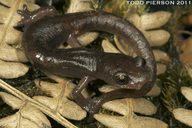|
Bolitoglossa huehuetenanguensis Campbell, Smith, Streicher, Acevedo & Brodie, 2010
Subgenus: Magnadigita | family: Plethodontidae subfamily: Hemidactyliinae genus: Bolitoglossa |
| Species Description: Campbell JA, Smith EN, Streicher J, Acevedo ME, Brodie Jr ED 2010 New salamanders (Caudata: Plethodontidae) from Guatemala, with miscellaneous notes on known species. Misc Publ Mus Zoology Univ Mich 200: 1-66. | |
 © 2011 Todd Pierson (1 of 3) |
|
|
|
Description When compared to B. huehuetenanguensis, B. mexicana have hands and feet that are more webbed, longer tails, and are generally larger. Bolitoglossa rufescens have pad-like hands, shorter tails and are smaller. A major diagnostic character between B. huehuetenanguensis and B. veracrucis is that B. veracrucis has broad, fully-webbed hands and feet, with a third toe that is triangular in shape. Bolitoglossa cuchumatana, on the other hand, have more extensively webbed feet, smaller hands and feet, and longer legs in females. Bolitoglossa huehuetenanguensis have longer tails, more maxillary and premaxillary teeth, and more intercostal folds in females than does B. la. Bolitoglossa engelhardti has a lengthier tail, and differently colored dorsolateral stripes. Bolitoglossa helmrichi have feet that are more webbed than in B. huehuetenanguensis. Bolitoglossa morio is bigger, with a dark grey to black color and pale marks on the flanks, and pale speckles all over the body. Bolitoglossa huehuetenanguensis is bigger and has more vomerine teeth than B. pacaya. Bolitoglossa rostrata is larger, but has shorter limbs and B. nussbaumi has less clear dorsolateral stripes, and lighter ventral coloration. Bolitoglossa centenorum is larger than B. huehuetenanguensis and has broader dorsolateral stripes. In comparison to B. huehuetenanguensis, B. ninadormida has less sharp but wider dorsolateral stripes, and has larger hands and feet (Campbell et al. 2010). In life, B. huehuetenanguensis may have a sharply defined copper or brass colored dorsal stripe on each side of its body, beginning in front of the eyes, and reaching or almost reaching the tip of the tail. Many small pale splotches are present on the dark grey-brown dorsal side of the salamander, and merges with the dorsolateral color and pattern. The sides of the animal are dark, and many lack pale patches; some have lateral patches of metallic colored flecks. Ventral coloration is pale with sparse melanophores; the chin is similarly colored. Their limbs are occasionally lighter than the lateral coloration with some light colored specks. When preserved, skin secretions turn yellow (Campbell et al. 2010). There appears to be sexual dimorphism with males B. huehuetenanguensis having fewer intercostal folds between adpressed limbs than females and males having 21 - 33 vomerine teeth and 49 - 74 premaxillary teeth, whereas females have 27 - 31 vomerine teeth and 57 - 87 premaxillary teeth. There is also variation between individuals of the dorsal stripe in the color (from copper to brass) and extent (anterior vs. posterior of the eye to nearly or at the tip of the tail. Coloration of markings also varied with most lateral dark surfaces missing pale blotchs, and some individuals including tiny metallic flecking. Some individuals had pale limbs with sparse pale flecks (Campbell et al. 2010). Distribution and Habitat Country distribution from AmphibiaWeb's database: Guatemala
Life History, Abundance, Activity, and Special Behaviors Many individuals had a skin secretion that reacted to preservatives to turn yellow (Campbell et al. 2010). Trends and Threats Comments The species authority is: Campbell, J. A., Smith, E. N., Streicher, J., Acevedo, M. E., and Brodie, E. D. Jr. (2010). “New Salamanders (Caudata: Plethodontidae) From Guatemala, with Miscellaneous Notes on Known Species.” Miscellaneous Publications Museum of Zoology University of Michigan, 200, 1-66. Based on genetic analysis of 12S and Cyt-B mitochondrial DNA, B. huehuetenanguensis is sister to B.ninadorminda and in a clade further with B. centenorum, B. helmirichi, B. cuchumatana, and B. nussbaumi. Bolitoglossa huehuetenanguensis is part of a larger subgenera called Magnadigita. Bolitoglossa huehuetenanguensis also appears to be closely related to B. rostrata (Campbell et al. 2010). Bolitoglossa huehuetenanguensis is named after the Guatemalan region where it is found, Huehuetenango, which includes most of the Sierra de los Cuchumatanes. The suffix, ensis, means place (Campbell et al. 2010). Bolitoglossa huehuetenanguensis was found with Abronia frosti, Incilius bocourti, Mesaspis moreletii, and Sceloporus taeniocnemis (Campbell et al. 2010).
References
Campbell, J. A., Smith, E. N., Streicher, J., Acevedo, M. E., Brodie, E. D. Jr. (2010). "New salamanders (Caudata: Plethodontidae) from Guatemala, with miscellaneous notes on known species." Miscellaneous Publications Museum of Zoology University of Michigan, 200, 1-66. [link] Originally submitted by: Michael Fu (first posted 2015-06-01) Species Account Citation: AmphibiaWeb 2015 Bolitoglossa huehuetenanguensis <https://amphibiaweb.org/species/7569> University of California, Berkeley, CA, USA. Accessed Nov 21, 2024.
Feedback or comments about this page.
Citation: AmphibiaWeb. 2024. <https://amphibiaweb.org> University of California, Berkeley, CA, USA. Accessed 21 Nov 2024. AmphibiaWeb's policy on data use. |



 Raffaëlli Account
Raffaëlli Account Map of Life
Map of Life